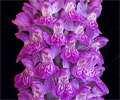|
|
|
|
|
| |
Flasks of
Dactylorhiza purpurella 'Inverness' × self |
|
| |
|
|
| |
| Number: |
TN5155 |
| Name: |
Dactylorhiza purpurella 'Inverness' × self
|
| Type: |
self (What's that?) |
|
Seed Donor: |
Kristine A. Holmberg
|
|
Click to Enlarge

Pod Parent Inflorescences |
Click to Enlarge

Pod Parent Flowers |
|
|
|
| |
For additional origin/habitat information supplied courtesy of
Charles and Margaret Baker, see further below, near the bottom of this page.
|
Temperatures we attempt to use in the lab & greenhouse:
| For Species: |
|
Spring, Summer, Autumn: days average 61°F, nights 51°F; best fit is Cool-Cold 64-44°F
(Source:
Baker's Web OSC) |
| For Species: |
|
Winter: days average 45°F, nights 38°F; best fit is Cold-Frigid 52-32°F
(Source:
Baker's Web OSC) |
|
About the name...
| Etymology of |
Dactylorhiza |
|
From latinized Greek "daktylos" finger; "rhiza" root. The root nodules are finger-like.
(Source:
Mayr & Schmucker 1998) |
| Etymology of |
purpurella |
|
From Latin "purpurellus" like purple, light purple.
(Source:
Mayr & Schmucker 1998) |
| Pronunciation of |
Dactylorhiza |
|
dak-til-oh-RYE-za
(Source:
Hawkes 1978) |
|
If you would like to direct someone to this web page, please copy and paste this URL into your email:
http://troymeyers.com/d?015155
| Flask Information |
| Availability: |
We have sold all of the flasks for this item. |
| You should: |
Consider getting individual plants or compots instead of a flask.
You can place a "Notify Flask Recipients" Request, and either we or a flask recipient may contact you when plants are available.
You may also place a "Notify Retries" Request, and if an identical pollination (the same parents) is done again, we'll let you know.
You may reserve a flask, but it's very unlikely you'll get one ...this could only happen if we found a flask that we didn't know we had. |
| Yield Estimate: |
270 plants (based on flask surveys done 08/22/2006 through 02/27/2007)
|
| Plantlet Sizes: |
From many flasks 15 - 75 mm plants (based on flask surveys done 01/29/2007 through 05/04/2007)
From one most recently surveyed flask 30 - 50 mm (05/04/2007)
|
|
You might also want to:
|
View the seed assay for this item.
View items of the same species.
View items of the same genus.
|
| Ordering Information |
| You are not currently logged in. |
|
You must be a registered user and be logged in to reserve a flask or place a notification request. Please log in:
|
|
|
|
|
|
| |
The origin/habitat information below is supplied courtesy of Charles and Margaret Baker
The following information is based on the name of the plant provided by the donor, and assumes that the name is correct. If the plant has been misidentified, then the following information may not be correct.
This text is copyrighted by the Bakers and may not be reproduced without permission.
ORIGIN/HABITAT: This orchid is distributed in the northern Atlantic region
from the northern and western British Islands to Scandinavia to as far
north as Sør Trøndelag and east to Jutland. Plants grow from near sea
level to about 1650 ft. (500 m) in full sun. They may be found on neutral
to slightly acidic soils with moist to wet substrates, growing in damp
coastal meadows or depressions between dunes, and occasionally even on the
drier dune slopes.
More about this information and the Bakers...
|
|
|
| |
|
|
|